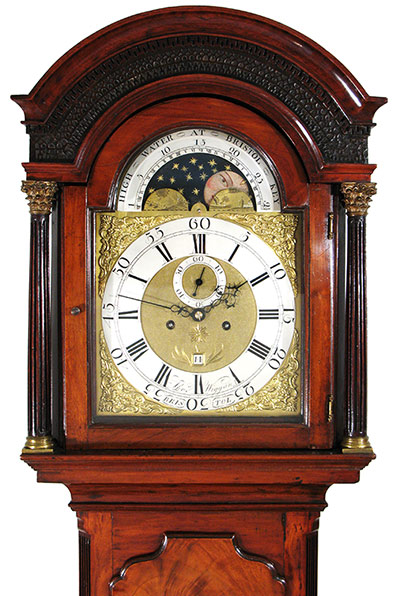George III Period mahogany longcase clock with lunar and tidal dials,
by Thomas Wiggan, Bristol
 Bristol in the west of England was a seat of great wealth from agriculture and shipping in the eighteenth century. Longcase clocks from the Bristol area are beautifully crafted and very distinctive in style, similar to London clocks in proportion and somewhat restrained compared to cases from further north in the country. The complex geometric fretwork above the dial is unique to this area of the West Country.
Bristol in the west of England was a seat of great wealth from agriculture and shipping in the eighteenth century. Longcase clocks from the Bristol area are beautifully crafted and very distinctive in style, similar to London clocks in proportion and somewhat restrained compared to cases from further north in the country. The complex geometric fretwork above the dial is unique to this area of the West Country.
Case: The case is of solid and veneered mahogany with pine secondary wood. The flame veneer on the trunk door is especially rich and the top of the door is nicely shaped. Hood columns are fluted and capped with brass Corinthian capitals. Restorations are minimal, and include minor repairs to the fretwork and finish. Feet are original, and the hood may have had a secondary, higher pediment on the top at one time. Color is a warm amber shade.
 Dial: The 12 inch brass and silvered dial is very nicely designed, with a lunar dial using gilded stars on a deep blue ground and high tide times for "Bristol Key" around the arch. The silvered seconds and date dials are contrasted with the matted center, and a stylized flower is incorporated in the center engraving. Spandrels are of a pattern catalogued at about 1760-1780. Hands are original, blued steel.
Dial: The 12 inch brass and silvered dial is very nicely designed, with a lunar dial using gilded stars on a deep blue ground and high tide times for "Bristol Key" around the arch. The silvered seconds and date dials are contrasted with the matted center, and a stylized flower is incorporated in the center engraving. Spandrels are of a pattern catalogued at about 1760-1780. Hands are original, blued steel.
Movement: Thomas Wiggan's four pillar movement is eight days duration with rack striking on a single bell, with lunar movement and calendar date. Escapement is anchor recoil. Weights are lead. Weights and pendulum appear to be original to this clock.
Maker: Thomas Wiggan (also spelled Wigan) is listed by Baillie as known to have been making clocks and watches in Bristol from 1760, and died in about 1790. Bristol clocks maintained their style over a long time, but we are estimating this one to be about 1770-1780.
Circa 1770-1780
7 Feet 5.5 Inches high
No. 1682